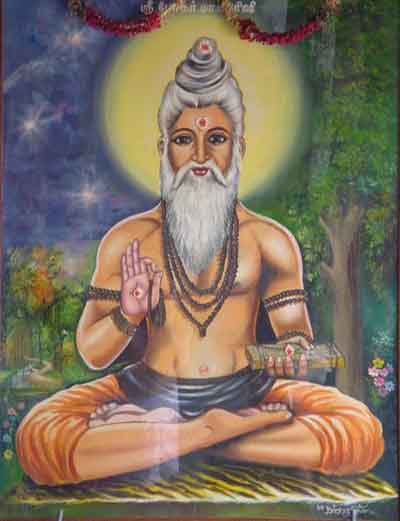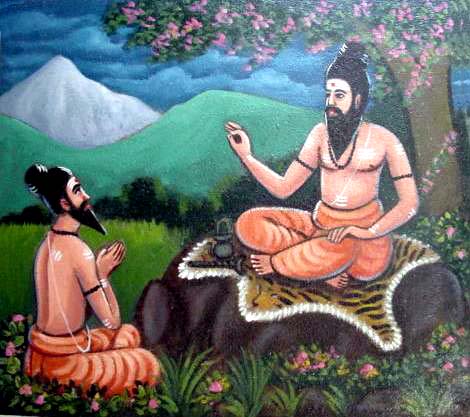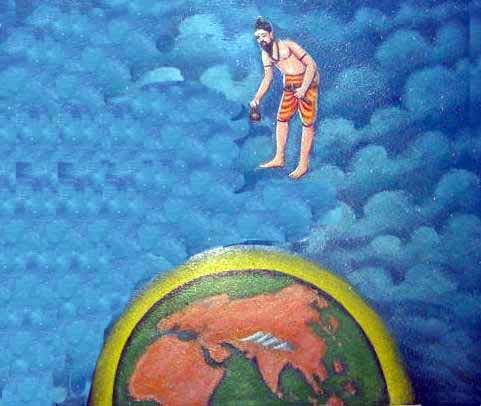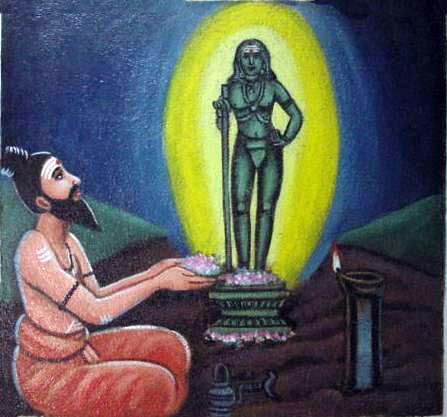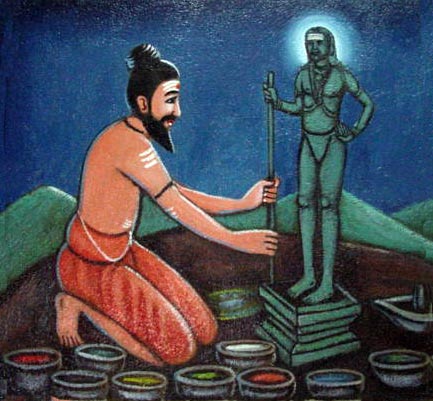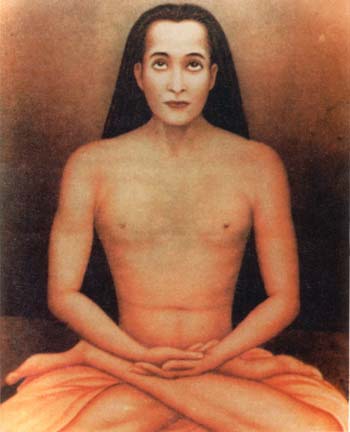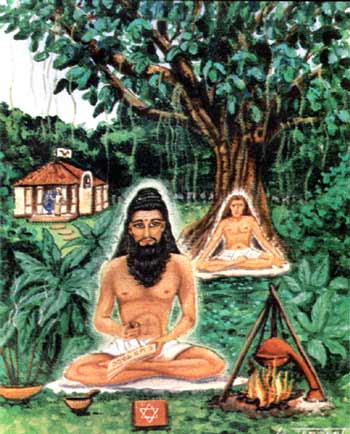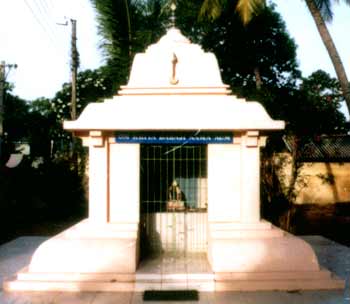
|
|||||||||||
|
| |||||||||||
Bhogar the Siddhar AlchemistBhogar was a legendary South Indian siddhar (a mystic, yogi). He was said to have miraculous powers. He is also said in some New Age circles to have been associated with Mahavatar Babaji. Bhogar was a South Indian by birth, belonging to the caste of goldsmiths, who became a siddhapurusha under the guidance of Kalanginaathar. In Bhogar’s Saptakanda he reveals details of various medicinal preparations to his disciple Pulippani (so named as he is believed to have wandered in the forests atop a puli or tiger) and at every stage he quotes his guru as the authority. Also Pulippani must have been a young man then, as he is often referred to as a balaka. It is said that as per the last wishes of his guru, Bhogar proceeded to China to spread the knowledge of siddha sciences and his journey is said to have been made with the aid of an aircraft; he demonstrated to the Chinese the details of the construction of the aircraft and later built for them a sea-going craft using a steam engine. The details of these and other experi- ments demonstrated by Bhogar in China are clearly documented in the Saptakanda. Bhogar’s guru, Kālāngi Nāthar, is believed to be a Chinese who attained siddhi in South India and thus became included among the Eighteen Siddhars. Lao Tse - the founder of Taoism (5th century B.C.) was the first Chinese to propound the theory of duality of matter — the male Yang and female Yin — which conforms to the Siddha concept of Shiva - Shakti or positive-negative forces. This very same concept was first revealed by the adi-siddhar Agasthya Rishi, whose period is as old as the Vedas, which have been conservatively dated at 3500 B.C. Also alchemy as a science was practised in China only after B.C. 135 and was practiced as an art until B.C. 175 when a royal decree was enacted banning alchemical preparation of precious metals by the Celestial Empire; these details are recounted in the two existing Chinese books of alchemy Shih Chi and Treatise of Elixir Refined in Nine Couldrons, both dated to the first century B.C. The emergence of Lao-Tse with his theory of duality of matter and the journey of Bhogar to China seem to have taken place about the same time and it is even possible that Bhogar himself went under the name of Lao-Tse in China, like another Siddharishi Sriramadevar, who was known as Yacob in Arabia. This seems likely considering that: before Lao-Tse the concept of duality of matter finds no mention in any Chinese treatise; alchemy as a science emerged only after B.C. 135, i.e. four centuries after Lao-Tse; there was a sudden spurt of alchemical practice aher the emergency of Lao-Tse; and the duality of matter and alchemy have been mentioned in South Indian scriptures that antidate Lao-Tse by centuries. Bhogar anticipating that in due course of period, human beings will suffer from large number of disease. As an expert in medicine he used 4448 rare herbs and made 9 poisonous medicine, mixing these 9 poisons into one needs great knowledege and skill, to make a Master Medicine (One medicine to cure all disease). Thirumoolar also discuss one such Master Medicine in his book Thiru Mandiram. With the consultation of Agasthiar (Father of Ayurvedic Medicine) and other siddhars Bhogar mixed the 9 poisons (Nava Bashanam) and made the Master Medicine in the form of Lord Murugan which is currently worshiped at Palani Murugan temple. There is a place near Palani Hill called Thanasiappan Temple which is the place were Bhogar mixed the Nava Bashanam and made the Murugan idol.
Bhogar and others then decided that by using the milk and panchamirtham (a sweet recipe) poured on the idol, one can extract the medicine from the idol. The milk and panchamritham then becomes medicine to cure disease. After installing Lord Murugan Navabashana idol at the Palani Hill, Bhogar used to worship it with milk abishegam (pouring milk on the idol) and panchamirtha abishegam (pouring panchamirtham on the idol). His disciple Pulipani siddhar then took over the job of Lord Murugan pooja after Bhogar went into Nirvigalpa Samadhi - the highest samadhi stage; where the Mind dissolves with Matter and Energy. Bhogar Samadhi is inside Palani Murugan temple at Palani Hill. Actually Bhogar himself constructed his samadhi exactly under the Lord Murugan Navabasha idol and went into Nirvigalpa Samadhi there. The entrance to his samadhi is a cave like structure, now also worship for this great siddhar is conducted at this entrance where he is last seen by his disciples which is at the Palani temple. The shrine at the top of the hill, though later than the Tiru Avinankudi temple, has overshadowed the older temple in the present century due to its popular appeal. Created by Bhogar, it was maintained after him by sage Pulippani and his descendants almost as their personal and private temple. During the time of Tirumalai Nayak, his general Ramappayyan handed over the puja rights to newly brought Brahmin priests. The descendants of Pulippani were compensated for the loss of this right by being given: Certain duties of superintendence; Right to some annual presents; Right to shoot off, at the Dasara Festival, the arrow which symbolises Subrahmanya’s victory over asuras; and the Right to be buried at the foot of the steps leading to the hill, if some of them so chose. Bhogar is a siddhar, who is considered as one of the eighteen siddhars born in the world. According to epigraphical sources and his book Bhogar Seven thousand his period is around 3000 B.C. Bhogar born at India and visited China in search of truth of life, he gained knowledge in medicine, astrology, spritiuality, yoga etc. Bhogar anticipating that in due course of period, human beings will suffer from large number of disease. As an expert in medicine he used 4448 rare herbs and made 9 poisonous medicine, mixing these 9 poisons into one needs great knowledege and skill, to make a Master Medicine (One medicine to cure all disease). Thirumoolar also discuss one such Master Medicine in his book Thiru Mandiram. With the consultation of Agasthiar (Father of Ayurvedic Medicine) and other siddhars Bhogar mixed the 9 poisons (Nava Bashanam) and made the Master Medicine in the form of Lord Murugan which is currently worshiped at Palani Murugan temple. There is a place near Palani Hill called Thanasiappan Temple which is the place were Bhogar mixed the Nava Bashanam and made the Murugan idol. The definition of enlightenment has many expressions; the value of perfection can turn the unreal into a spectacular world of intrigue of what is possible in this world that we live in. In the era 3000 B.C. that we so misjudged as belonging to the primitive period has recorded the life of at least one person who surpassed most human beings in the quest for knowledge and the power of wisdom. 3000 B.C. a world that was still waking up to evolution witnessed the presence of Siddhar Bhogar, a powerful astrologer, and a yogi who had mastered the science of medicine perfectly. The highlights of his life maybe plenty but those that would intrigue us today are recorded in the Saptakanda, a work that describes in detail the presence of an aircraft that took him all the way to China where he imparted his knowledge. Another intriguing fact is that he used 9 poisons or the Nava Bhashanam to make a statue of Lord Muruga (Dandapani vigraha) which has since been installed in the Murugan temple at Palani near Madhurai and is still worshipped. The interesting aspect of this idol is that its composition of 9 poisons (made out of 4000 rare herbs), elicits life giving essence into the fluids of libation as the abhishekam progresses which cures all human diseases when consumed. Siddhar Bhogar’s shrine, his Samadhi is what remains today as a powerful example of the difference in lifestyle, the deep rooted principles and values that once governed the people of this soil. We all live in the same world, making use of probably the same things to evolve, yet the intensity of worship and the much needed awareness to realize these methods of living are not half as strong now. Few things come to light in the life of this phenomenon called Siddhar Bhogar. He initially worshiped the Kamandalam on the peetha and the rishi muni dandam or staff atop the hill at Palani. He subsequently prepared the idol of Muruga (Dandapani vigraha) out of 9 poisons that magically cures people of their ailments when the fluids of libation are consumed after abhishekam. Bhogar is known to have made his own Samadhi, his final resting place in this form which is a cave he dug out, a chamber under the very idol of Muruga (Dandapani vigraha). It was here that he took Jeeva Samadhi. Siddhar Bhogar lived for aprox. 300 years and 18 days. The life of Siddhar Bhogar is amazing, intriguing and gives us an idea of a world we wish we were a part of. Few have brought alive the picture of his Samadhi, and among those who have is Artist Silpi who has vividly captured every essence of what is found back in this cave that still exalts Siddhar Bhogar’s energy. This is a potent place of worship, which is crowned by a throne that was created by Siddhar Bhogar himself. He used the eight shaktis, the Nava Durga, Sri Bhuvaneshwari, and most importantly the Maragadha Lingam (emerald Linga) that crowns this throne. It is a complex vigraha comprising of a stone altar that hosts the main emerald Shiva Linga at the top surrounded by the Goddesses at various levels. As part of the worship is also the present the right faced conch shell, and two yantras that capture the essence of the Goddess and Lord Shiva within them. It is a potent world, energized not just by the presence of a dual yantra, but by the powerful magnetic field present in the Samadhi of this great Siddhar. The passage way to heaven is not just a journey down spiritualism, but a unique magical world of powers expressed in various forms depicted through the life of this great Siddhar. Few others are blessed to express this beauty by representing it in color for lesser mortals like us. The profound depth of sacred reality is rendered by Artist Silpi in this painting who spent 40 days within this cave to capture this unique throne for the world to witness, a throne found nowhere else, a profound example of salvation being found in intense devotion be it science, medicine, art and sculpture to inspire humanity in the years to come.
|
